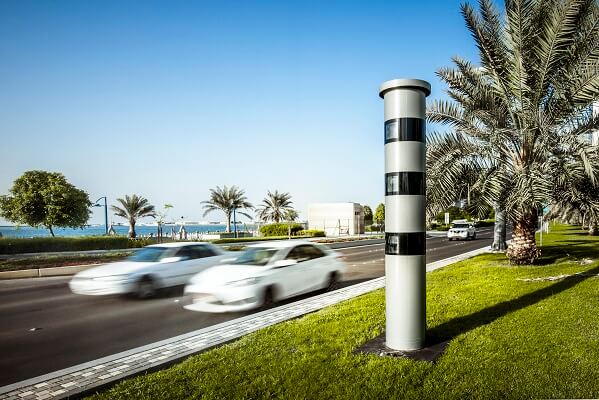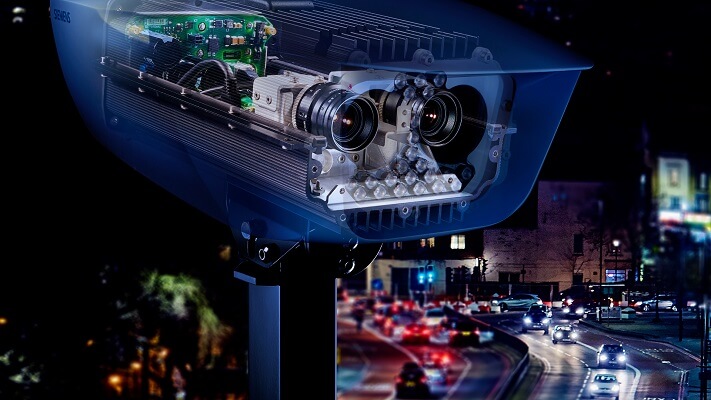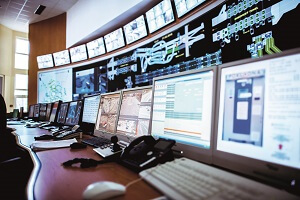To properly curb dangerous driving behavior such as speeding and running red lights, law enforcement authorities require tools that can help them not only monitor traffic speeds, but also catch the motorists in the act.
To properly curb dangerous driving behavior such as speeding and running red lights, law enforcement authorities require tools that can help them not only monitor traffic speeds, but also catch the motorists in the act. The technology needs to be accurate and reliable enough to provide evidence that can stand up in court as well as be tough enough to withstand the dynamic and challenging environments and weather conditions that exist on roads and highways.
When asked about the various technologies that are being widely used in the Middle East region to combat these challenges, Chen Xin, Sales Director for Middle East at
Dahua Technology, enumerated the following: “Radar cameras and speed measurement systems are utilized to deter speeding vehicles and thereby reduce accident rates on the road. ANPR is applied to reduce the human resource cost for traffic violation detection. High resolution (4K) Starlight sensor is used to overcome adverse lighting conditions at night and extreme contact under direct sunlight.”
 Chen Xin,
Chen Xin,
Sales Director for Middle East,
Dahua Technology,
In the past, law enforcement relied on a combination including but not limited to devices such as electronic speed limit signs and the so-called “wet film speed cameras,” systems that consisted of a camera attached to a radar unit that measures a vehicle’s speed. Image capture is triggered when it detects a speeding vehicle. Video-based technology at the time required a human operator nearby to monitor the images and videos and pick out traffic violators.
However, over the recent years, the equipment used in this field have developed t remendously. Speed detection accuracy grew with the development of advanced radar and LIDAR technology. Cameras are now producing HD/high resolution images and videos, arming law enforcement officials with real-time views of ongoing events on the the roads and are capable of tracking multiple objects at a time. Video analytics, such as automatic number plate recognition (ANPR), are now widely used in this sector, minimizing the need for human intervention and the risk of human error.
Nowadays, the trend in traffic enforcement systems involves incorporating different components into one solution; thus multiplying its applications and driving cost-effectiveness — offering red light, ANPR and average speed monitoring at one go, in addition to functionalities such as fixed and mobile speed enforcement. Some can even provide officials with other important information like seatbelt violations or tailgating.
VITRONIC, a Germany-based company that provides industrial machine vision-based solutions for traffic enforcement, has its laser-based systems and products currently being used for various traffic control projects in the UAE, KSA, Qatar, Oman and Iraq. “The applied POLISCAN FM1 is the next generation of VITRONIC’s LIDAR enforcement system, which is able to track multiple vehicles across several lanes, determining their position and measuring their speed, even in dense traffic,” said John Yalda, Sales Coordinator for Traffic Technology in the MENA Region for
VITRONIC.
“Moreover, the system can detect multiple offenses such as speeding, red light violations, lane based offenses and tailgating. The speed enforcement systems can be installed for instance in portable housings as done in KSA, which can be circulated between preconfigured deployment sites,” added Yalda.
 POLISCAN FM1
POLISCAN FM1
Source: VITRONIC
According to Theml, the latest enforcement platform from Siemens, Sicore II, is designed to support a host of enforcement applications which are appropriate for the MEA region including emerging enforcement applications such as average speed (point to point), Don’t Block The Box/ intersection blocking as well as the traditional enforcement scenarios (red light/speed enforcement, etc.). Siemens previously finished an installment of a combined speed and red light enforcement system on Reem Island in Abu Dhabi.
Some of the current traffic systems still transmit the captured images and videos to a central control room for processing. But the rise in the number of intelligent traffic enforcement cameras and systems means that it is now capable of analyzing traffic situations, alerting officials of important events unfolding on the roads and automatically generate tickets and fines.
“Edge analytics on board CCTV cameras have jumped in popularity based on the massive technological advancements we’ve experienced over the past 3-5 years. So have onboard surveillance and real-time processing which enable officers to capture number plates as they drive via ANPR systems and process information in real time,” said Ettiene Van Der Watt, Regional Engineering and Training Manager for Middle East and Africa at
Axis Communications. “ANPR onboard CCTV cameras is cost effective and extremely reliable and going forward we see a higher demand for these technologies as more regulatory authorities see huge benefits in adding these simplistic solutions.”
 John Yalda,
John Yalda,
Sales Coordinator for Sales Traffic Technology,
MENA Region,
VITRONIC
Machine vision is slowly but surely making its way into various verticals, the traffic enforcement sector included. However, its progress may be in some ways hampered by difficulties posed by this field, such as extreme harsh weather conditions, constant changes in traffic flow and conditions. The fact that each region or country may have different traffic regulations or speed limits serve to make things even more complicated.
Despite this, the many benefits that this can bring are clearly evident, pushing the use of this technology foward. As these devices are able to function by themselves, there will be a decrease in the need to live-stream the video back to the control room; thus dramatically reducing bandwidth. Immediate image processing and interpretation will cut down the need for additional manpower and allow the authorities to focus on time-sensitive, critical incidents instead.
However, there is a unique challenge in the region that adversely affects, or maybe even limit, the wide-spread application of ANPR technology in the region. “For the traffic law enforcement in different countries of Middle East region, such as UAE, Saudi, Oman and Kuwait, the major challenge is that these countries do not share the same or similar plate number combination system,” said Chen. “This augments the difficulty for law enforcement agencies to track down involved cars accurately and efficiently to impose proper traffic violation penalty. Besides, the current law enforcement system requires too many police force but still delivers a result not plausible enough.”
As government agencies are trying to get the most of these systems, this can also lead to a new set of complications. “One of the challenges with these newer technologies is that they fulfill multiple use cases, for example, the Department of Transport is interested in keeping the intersections clear for traffic efficiency purposes; however, the police/Ministry of Interior want to enforce traffic violations for the purposes of traffic contravention/ticket purposes. This inter-agency working is something that requires close alignment which can be difficult across the world, and is no different in the MEA,” said Klaus Theml, Head of ITS Middle East at
Siemens.
 Source: Siemens
Source: Siemens
Getting the big picture with ITS
Traffic enforcement is an essential part of ensuring road safety. However, we will be remiss on focusing on that alone. As the saying goes “Prevention is better than a cure.” If law enforcement agencies can get access to reliable and detailed real-time traffic data and videos or alerts., this will enable better traffic management and, perhaps, decreasing cases of risky driving behaviors from motorists trying to rush through traffic.
“With intelligent video applications, you can get automatic alerts when the traffic flow deviates from normal. Early detection of congestion, accidents or stopped vehicles makes it possible to quickly bring the traffic back to normal again — so everyone on the streets can get from point A to point B as quickly and safely as possible. As optimized traffic flow systems increase so do the demand for connectivity, getting real-time information and being able to decide on the correct actions has endless advantages,” said Van Der Watt.
This is the reason why many agencies are now considering traffic law enforcement technologies as an integral part of intelligent transport systems (ITS), offering red light enforcement, speeding detection, bus lane enforcement, parking violations, real-time traffic status displays and traffic signal controls under one umbrella. Automatic road enforcement can also be used by law enforcement officers to investigate crimes by cross-referencing vehicle registrations and criminal records, even for cases of identifying suspects through face recognition.
“As a system that has been proven to save lives, the intelligent traffic system is widely deployed in cities worldwide. The traffic enforcement system is an important component of ITS, not only helping drivers to strengthen their awareness when driving, but also generating additional revenue from fines to help finance a sustainable, growing and well-maintained enforcement system. The Dahua Road Safety Enforcement Solution is a unique and comprehensive suite of tools which can detect multiple traffic violations in order to improve road efficiency and safety,” said Chen.
“Big data-based video analytics applied in ITS enforcement systems and deep learning powered video structure system applied in traffic systems are very likely to come into use in the near future. They can help the government to decide the category of each metadata from the video,” added Chen.
 Source: Axis Communications
Source: Axis Communications
Smart traffic enforcement for the future
The number of vehicles on roads is increasing every year, a trend that will only rise as the Middle East continues on its growth path. The last few years have seen advancements and an increase in intelligent traffic enforcement technologies that are helping local governments cope with rising congestion and risk of road accidents.
By keeping up with the latest products and selecting ones that work for their particular specifications, the countries of this region is well on their way to realizing their vision of creating safer cities and road for its people.